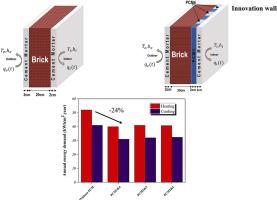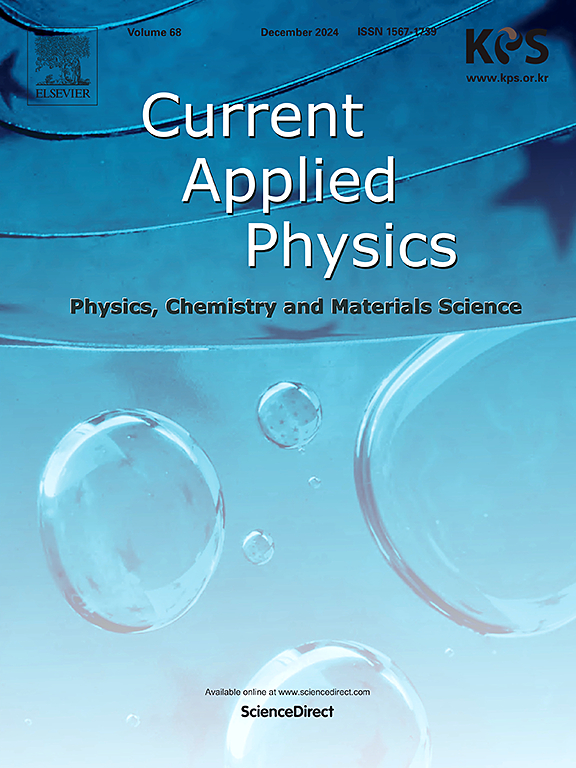相变材料和建筑围护结构:能源转换的创新解决方案
IF 3.1
4区 物理与天体物理
Q3 MATERIALS SCIENCE, MULTIDISCIPLINARY
引用次数: 0
摘要
在气候恶劣的地区,建筑的能源效率是一项严峻的挑战,因为这些地区的供暖和制冷需求正在稳步增长。在最有前途的被动式策略中,将相变材料(PCMs)集成到建筑围护结构中可以储存和释放潜热,从而稳定室内温度并降低整体能耗。本研究采用瞬态CFD模拟,提出并评估了一种创新的墙体系统,该系统包含两个平行排列的PCM层,专门针对马拉喀什的半干旱气候进行了定制。这项工作的新颖之处在于同时对三个关键设计因素进行参数化分析:PCM类型、厚度和墙内的空间定位。结果表明,与没有pcm的参考墙相比,PCM1(29°C) + PCM4(16°C)配置提供了最佳性能,将室内温度波动减少了40%以上,并将年能源需求降低了24%。温度轮廓分析揭示了更均匀的热分布,而粘度场可视化提供了对熔化和凝固循环进展的有价值的见解。这些发现强调了PCMs作为一种有效的被动解决方案在炎热干旱气候下提高能源效率和热舒适性的战略作用。该研究建立了一个适合北非条件的可复制的气候响应框架,为在可持续建筑设计中更广泛地采用pcm铺平了道路。本文章由计算机程序翻译,如有差异,请以英文原文为准。

Phase change materials and building envelope: An innovative solution for energy transition
The energy efficiency of buildings is a critical challenge in regions with harsh climates, where heating and cooling demands are steadily increasing. Among the most promising passive strategies, the integration of phase-change materials (PCMs) into building envelopes enables latent heat storage and release, thereby stabilizing indoor temperatures and reducing overall energy consumption. This study employs transient CFD simulations to propose and assess an innovative wall system incorporating two PCM layers arranged in parallel, specifically tailored to the semi-arid climate of Marrakesh. The novelty of this work lies in the simultaneous parametric analysis of three key design factors: PCM type, thickness, and spatial positioning within the wall. Results indicate that the PCM1 (29 °C) + PCM4 (16 °C) configuration delivers the best performance, reducing indoor temperature fluctuations by over 40 % and lowering annual energy demand by up to 24 % compared to a reference wall without PCMs. Temperature contour analyses revealed a more uniform thermal distribution, while viscosity field visualizations provided valuable insights into the progression of melting and solidification cycles. These findings underscore the strategic role of PCMs as an effective passive solution for enhancing energy efficiency and thermal comfort in hot, arid climates. The study establishes a reproducible and climate-responsive framework tailored to North African conditions, paving the way for the broader adoption of PCMs in sustainable building design.
求助全文
通过发布文献求助,成功后即可免费获取论文全文。
去求助
来源期刊

Current Applied Physics
物理-材料科学:综合
CiteScore
4.80
自引率
0.00%
发文量
213
审稿时长
33 days
期刊介绍:
Current Applied Physics (Curr. Appl. Phys.) is a monthly published international journal covering all the fields of applied science investigating the physics of the advanced materials for future applications.
Other areas covered: Experimental and theoretical aspects of advanced materials and devices dealing with synthesis or structural chemistry, physical and electronic properties, photonics, engineering applications, and uniquely pertinent measurement or analytical techniques.
Current Applied Physics, published since 2001, covers physics, chemistry and materials science, including bio-materials, with their engineering aspects. It is a truly interdisciplinary journal opening a forum for scientists of all related fields, a unique point of the journal discriminating it from other worldwide and/or Pacific Rim applied physics journals.
Regular research papers, letters and review articles with contents meeting the scope of the journal will be considered for publication after peer review.
The Journal is owned by the Korean Physical Society.
 求助内容:
求助内容: 应助结果提醒方式:
应助结果提醒方式:


